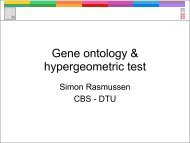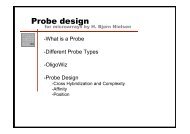Computational tools and Interoperability in Comparative ... - CBS
Computational tools and Interoperability in Comparative ... - CBS
Computational tools and Interoperability in Comparative ... - CBS
Create successful ePaper yourself
Turn your PDF publications into a flip-book with our unique Google optimized e-Paper software.
166<br />
literally millions of bacterial species, only a small proportion<br />
of these can be grown <strong>in</strong> the laboratory (H<strong>and</strong>elsman<br />
2004). Bacteria (<strong>and</strong> Archaea) can be found almost<br />
anywhere <strong>in</strong> the environment: <strong>in</strong> the air, even <strong>in</strong> the<br />
International Space Station (Novikova et al. 2006), <strong>in</strong><br />
thermal ducts found at great depths <strong>in</strong> the oceans (Ala<strong>in</strong> et<br />
al. 2002; Vezzi et al. 2005), <strong>in</strong> the <strong>in</strong>test<strong>in</strong>al tracts of<br />
animals (Yan <strong>and</strong> Polk 2004; Backhed et al. 2005) <strong>and</strong> <strong>in</strong><br />
soil <strong>and</strong> rocks, even thous<strong>and</strong>s of meters deep (Torsvik et<br />
al. 1990). Bacteria live with<strong>in</strong> unicellular eukaryotes,<br />
algae, plants or animals. This diversity is reflected <strong>in</strong> their<br />
physiology, morphology, metabolism <strong>and</strong> ecosystems. For<br />
example, from a physiological perspective, most <strong>in</strong>test<strong>in</strong>al<br />
bacteria such as Escherichia coli are motile by means of<br />
flagella, to overcome the peristalsis of the gut, whilst the<br />
soil bacterium Clostridium perfr<strong>in</strong>gens does not posses<br />
such motility mach<strong>in</strong>ery (Shimizu et al. 2002). From a<br />
metabolic perspective, the versatile Burkholderia cepacia<br />
(formerly Pseudomonas cepacia) can utilise approximately<br />
100 different organic compounds as a sole energy source<br />
(Goldmann <strong>and</strong> Kl<strong>in</strong>ger 1986) compared to the strictly<br />
<strong>in</strong>tracellular Mycobacterium tuberculosis which is dependent<br />
on only a few carbon sources produced by its<br />
<strong>in</strong>voluntary host. From an <strong>in</strong>ter-bacterial <strong>in</strong>teraction<br />
perspective, sometimes bacteria cooperate. For example,<br />
Enterobacter cloacae <strong>and</strong> Pseudomonas mendoc<strong>in</strong>a positively<br />
<strong>in</strong>teract to stimulate plant growth (Duponnois et al.<br />
1999). On the other h<strong>and</strong>, there are also bacteria which not<br />
only “do not cooperate” but exhibit predatory behavior,<br />
such as Bdellovibrio bacteriovorus (Rendulic et al. 2004).<br />
As for bacteria–host <strong>in</strong>teractions, for a given bacterial<br />
species both pathogenic <strong>and</strong> non-pathogenic stra<strong>in</strong>s can<br />
exist (Dobr<strong>in</strong>dt <strong>and</strong> Hacker 2001; Penyalver <strong>and</strong> Lopez<br />
1999), while other species may be exclusively parasitic<br />
(Goebel <strong>and</strong> Gross 2001), truly symbiotic (Gil et al. 2004)<br />
or commensal (Yan <strong>and</strong> Polk 2004) for their host. It is<br />
<strong>in</strong>terest<strong>in</strong>g to note that this diversity is somehow captured<br />
<strong>in</strong> the relatively small bacterial genomes.<br />
The first complete viral genome (φX174) was published<br />
<strong>in</strong> 1977 (Sanger et al. 1977). To put this <strong>in</strong>to perspective, to<br />
sequence the 4.6-Mbp E. coli K-12 genome at that time<br />
(about a thous<strong>and</strong> base pairs (bp) could be sequenced per<br />
year <strong>in</strong> 1977) would take more than a thous<strong>and</strong> years to<br />
f<strong>in</strong>ish, <strong>and</strong> to sequence the human genome would take<br />
more than a million years to complete. The automation of<br />
sequenc<strong>in</strong>g methods, the <strong>in</strong>vention of polymerase cha<strong>in</strong><br />
reaction (PCR) (Mullis et al. 1986) <strong>and</strong> the shotgun clon<strong>in</strong>g<br />
procedure reduced costs <strong>and</strong> time, <strong>and</strong> provided the<br />
capability for large-scale sequenc<strong>in</strong>g. These developments<br />
together have led to the sequenc<strong>in</strong>g of the first complete<br />
bacterial genome (Fleischmann et al. 1995) almost 20 years<br />
after the sequenc<strong>in</strong>g of φX174. The choice of the first<br />
bacterium to be completely sequenced (H. <strong>in</strong>fluenzae Rd<br />
KW20) was based on the follow<strong>in</strong>g reasons: (1) the<br />
genome size was thought to be ‘typical’ among bacteria<br />
(1.8 Mbp), (2) the G + C base composition was close to that<br />
of the human genome (38%) <strong>and</strong> (3) the bacterium had<br />
important human health implications. In the absence of<br />
procedures to produce a genetic map for the species,<br />
genome sequenc<strong>in</strong>g was proven to be a powereful<br />
alternative for genetic characterisation. This l<strong>and</strong>mark<br />
work <strong>in</strong>itiated the <strong>in</strong>flux of genome sequence data which<br />
is now updated frequently <strong>and</strong> is publicly available. As of<br />
November 2005, there are more than 300 fully sequenced,<br />
publicly available bacterial genomes. Figure 1 shows this<br />
<strong>in</strong>crease of sequence data over the past decade. 1<br />
The total number of completed bacterial genome<br />
sequences has more than doubled over the past 2 years<br />
<strong>and</strong>, at the time of writ<strong>in</strong>g, there are 855 publicly listed<br />
bacterial <strong>and</strong> archaeal genome projects that are <strong>in</strong> various<br />
stages of progress. 2 In addition to new species, multiple<br />
stra<strong>in</strong>s of the same bacterial species are be<strong>in</strong>g sequenced.<br />
The amount of genomic data currently available has<br />
provided significant advances <strong>in</strong> our underst<strong>and</strong><strong>in</strong>g of a<br />
number of important themes, <strong>in</strong>clud<strong>in</strong>g bacterial diversity,<br />
population characteristics, operon structure, mobile genetic<br />
elements (MGE) <strong>and</strong> horizontal gene transfer (HGT). It has<br />
also provided a number of challenges <strong>in</strong> underst<strong>and</strong><strong>in</strong>g the<br />
ecology of, as yet, undiscovered bacterial worlds. The<br />
availability of whole genome sequences for pathogenic <strong>and</strong><br />
commensal bacterial species has allowed a more detailed<br />
analysis of the complex <strong>in</strong>teractions that occur with their<br />
plant or animal hosts. Figure 2a is a phylogenetic tree of<br />
300 sequenced bacterial genomes (available at the time of<br />
writ<strong>in</strong>g). Many of these genomes are from pathogenic<br />
bacteria liv<strong>in</strong>g <strong>in</strong> complex ecosystems, such as the<br />
spirochaete Brachyspira pilosicoli labelled <strong>in</strong> red <strong>in</strong> the<br />
phylogenetic tree shown <strong>in</strong> Fig. 2b. This bacterium attaches<br />
to enterocytes to form a “false brush border” <strong>in</strong> the colon.<br />
Most genome sequenc<strong>in</strong>g projects are currently carried<br />
out us<strong>in</strong>g automated applications of the sequenc<strong>in</strong>g<br />
technique developed by Sanger et al. (1973), but newly<br />
developed methodologies may enable even more rapid<br />
sequenc<strong>in</strong>g <strong>in</strong> the future. Two papers have been published<br />
about two different methods for high-throughput sequenc<strong>in</strong>g<br />
of bacterial genomes (Pennisi 2005). One method is<br />
essentially a “do-it-yourself kit”, which uses a laser<br />
confocal microscope <strong>and</strong> other “off-the-shelf” components<br />
to build a sequenc<strong>in</strong>g mach<strong>in</strong>e capable of sequenc<strong>in</strong>g an E.<br />
coli genome <strong>in</strong> less than a day (Shendure et al. 2005). The<br />
second method is a commercial mach<strong>in</strong>e, based on<br />
pyrosequenc<strong>in</strong>g methodologies to generate many short<br />
pieces of DNA; this method was used to sequence a<br />
bacterial genome with<strong>in</strong> a few hours (Margulies et al.<br />
2005). Although there are still some technical problems<br />
with both of these methods, it is clear that, <strong>in</strong> the near<br />
future, it will be possible to quickly sequence a bacterial<br />
genome at a considerably low cost.<br />
1 Completed genome statistics obta<strong>in</strong>ed from the <strong>CBS</strong> atlas web<br />
pages http://www.cbs.dtu.dk/services/GenomeAtlas<br />
2 http://www.ncbi.nlm.nih.gov/entrez/query.fcgi?db=genomeprj









